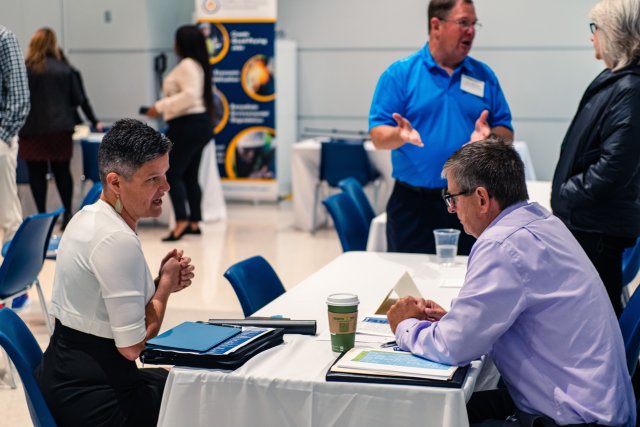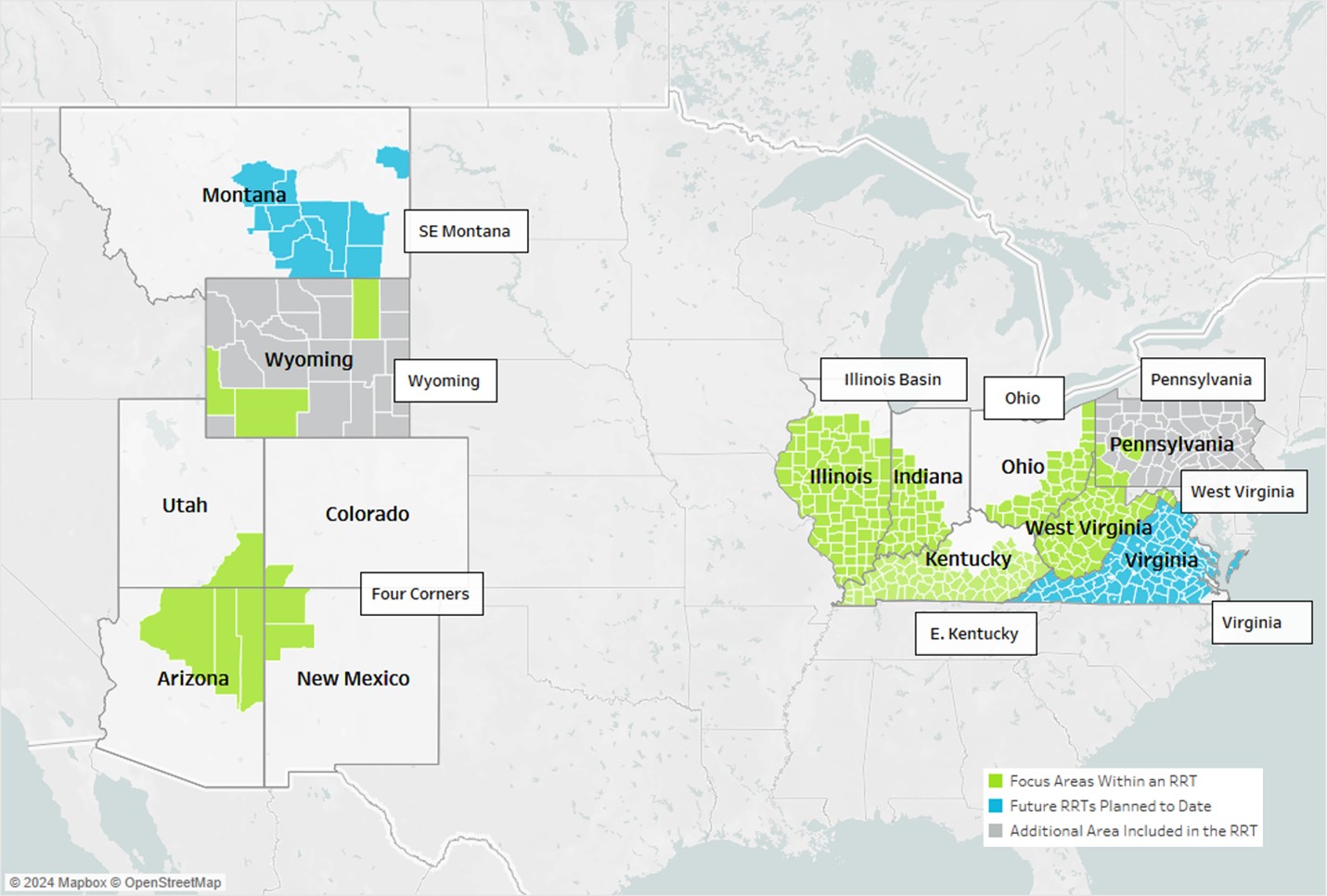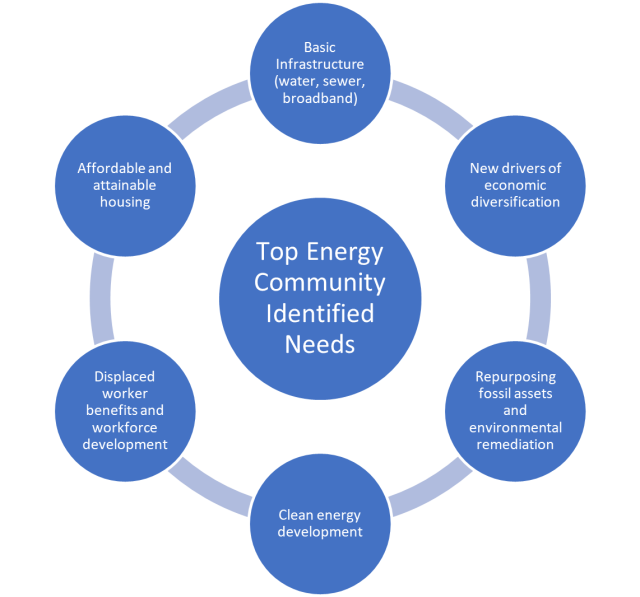EPA Engagement with Energy Communities
Energy communities are places where a significant percentage of jobs and tax revenue come from the extraction, processing, transport, and energy production of fossil fuels. Many of these communities seek to diversify their economies and invest in transportation, water, information and other infrastructure they need. EPA is committed to its core mission to protect human health and the environment and is working with energy communities across the country to provide innovative ideas, strategic guidance and staff capacity to support their goals.
On this page:
- Rapid Response Teams
- Energy Communities’ Stated Priorities
- EPA Financial Assistance to Energy Communities
- EPA Technical Assistance to Energy Communities
- EPA Resources for Energy Communities
- Impact in Energy Communities
Rapid Response Teams
EPA has long-standing methods for providing in-kind technical assistance to communities interested in supporting economic growth opportunities that diversify their economies and support improved environmental outcomes. Through direct assistance and the relationships built with partners on the ground, EPA supports energy communities as they make progress on their energy transition goals.

EPA’s approach to coordinating resources from across federal, state and local government to proactively address community needs helped catalyze the formation of Rapid Response Teams. RRTs work with energy community members to identify economic transformation and revitalization goals, figure out ways to pursue those goals, and make the connections between programs across the federal government and up and down levels of state and local government. RRTs aim to understand the needs of energy communities and work to tackle barriers to meeting those needs.
Beginning in fall 2021, EPA began meeting twice monthly with state officials in the Wyoming Governor’s office, the University of Wyoming, Wyoming Business Council, local officials (including the counties of Lincoln, Converse, Sweetwater, and Campbell), labor organizations, environmental organizations, electric co-ops and others. This group formed the first RRT and supported Wyoming by employing listening and learning as the foundation for exploring solutions to barriers for economic growth and identifying programs to support expanding the energy sector.
This RRT model has since been expanded to other coal-impacted areas of the country that have identified a need to support potential pathways for economic growth and the community-based infrastructure to needed to support their further development.

Energy Communities' Stated Priorities

Many energy communities see improving energy and basic infrastructure as a top priority along with workforce training and housing improvements.
Energy communities often need support, capacity-building and tools to develop more diversified economies.
The top energy community identified needs are:
- Basic infrastructure (water, sewer, broadband).
- New drivers of economic diversification.
- Repurposing fossil assets and environmental remediation.
- Clean energy development.
- Displaced worker benefits and workforce development.
- Affordable and attainable housing.
EPA Financial Assistance to Energy Communities
EPA directs funding to community-based projects and technical assistance across the U.S. to enable environmental regeneration and economic revitalization. Learn more about the impact of financial assistance in energy communities.
In addition, EPA has many annual financial assistance programs that can help communities address vital needs.
Resources for Drinking Water
The Infrastructure Investment and Jobs Act provided funding for additional investment in drinking water, wastewater, water reuse, conveyance and water storage infrastructure, including dedicated funding to replace lead service lines and address PFAS (per- and polyfluoroalkyl substances). Improvements to water infrastructure are a frequently stated need for energy communities as they look to revitalize their economies. EPA’s funded drinking water programs have provided assistance to states and communities.
Clean Ports Program
Ports can be a significant source of diesel pollution, and those living near ports that bear the brunt of this pollution. The Clean Ports Program provides funding for zero-emission port equipment and infrastructure as well as air quality planning at U.S. ports. This will ensure that our nation’s ports, a critical part of our infrastructure and supply chain, address public health and environmental impacts on surrounding communities.
Brownfields Program
EPA's Brownfields Program empowers states, communities, and other stakeholders to work together to prevent, assess, safely clean up, and reuse brownfield sites. A brownfield site is real property, where the expansion, redevelopment, or reuse of land may be complicated by the presence or potential presence of a hazardous substance, pollutant, or contaminant. The Small Business Liability Relief and Brownfields Revitalization Act of 2002, as amended by the Brownfields Utilization, Investment and Local Development Act of 2018, was passed to help states and communities around the country clean up and revitalize brownfield sites. Under this law, EPA provides financial assistance to eligible applicants through five competitive grant programs:
- Multipurpose Grants.
- Assessment Grants.
- Revolving Loan Fund Grants.
- Cleanup Grants.
- Job Training Grants.
Additionally, funding support is provided to state and tribal response programs through a separate mechanism.
Standing Grants Programs
EPA awards funding for grants and other assistance agreements. From small non-profit organizations to large state governments, EPA works to help many organizations achieve their environmental goals. EPA grants remain an important tool to protect human health and the environment. Learn more about grants at EPA.
EPA Technical Assistance to Energy Communities
Energy Communities Technical Assistance Program
In May 2024, EPA announced two communities to receive technical assistance as part of the Energy Communities Technical Assistance Pilot program. The program supports community-driven goals toward energy transition, including coal mine and power plant reuse and redevelopment, community revitalization and workforce transition for eligible communities in Rapid Response Team regions. This assistance provides selected communities with planning support that centers around a two-day community workshop, where a team of experts will help community members develop an implementable action plan that promotes environmental and economic revitalization. After the workshop, the community continues to use their experience to consult with EPA and a team of consultants as they develop a playbook that can assist other communities across the country with similar energy transition goals.
Building Blocks for Sustainable Communities Program
EPA's Building Blocks for Sustainable Communities program provides technical assistance with the goal to build a partnership between EPA and local communities to pursue development strategies that expand upon existing Brownfields (contaminated properties) clean-up efforts and advance clean air, clean water, sustainable development and other local goals.
Water Technical Assistance Programs
Existing EPA WaterTA initiatives are available for utilities, municipalities, and Tribes to receive direct WaterTA to maintain regulatory compliance, improve resiliency, and build utility technical, managerial, and financial capacity. Learn about initiatives and resources and to request assistance.
- H2O Community Solution Teams: This program support communities to assess water infrastructure needs and make progress in accessing federal Infrastructure Investment and Jobs Act funding.
- Closing America's Wastewater Access Gap: The program expands on the services provided in the Closing America's Wastewater Access Gap pilot initiative to provide technical assistance to approximately 150 communities with decentralized wastewater needs (or no wastewater infrastructure at all).
- Request no-cost assistance by completing the WaterTA request form. Communities – including homeowners and utilities – and all states, Tribes, and territories can complete the request form.
- Communities will be selected on a rolling basis; there is no deadline to apply. For questions, email SepticHelp@epa.gov.
Recreation Economy for Rural Communities
Recognizing that outdoor recreation is a large and growing sector of the economy nationwide, the Recreation Economy for Rural Communities program provides planning assistance to small towns and rural communities to help them boost their outdoor recreation economy and revitalize their main streets. The program is a partnership between EPA's Office of Community Revitalization, USDA Forest Service, Northern Border Regional Commission, Appalachian Regional Commission and Denali Commission.
Local Foods, Local Places
The Local Foods, Local Places planning assistance program helps cities and town across the country engage with stakeholders to develop local food systems, preserve open space and farmland, revitalize Main Streets and downtowns, boost economic opportunities for farmers and businesses, and improve access to local and healthy foods.
EPA Resources for Energy Communities
- Local Foods, Local Places Toolkit: Communities can find a toolkit and case studies to guide them through the process of convening their own LFLP workshop.
- EPA’s Land Revitalization Program: The Land Revitalization Program can help communities identify possibilities for reusing a contaminated, or potentially contaminated site. Site reuse planning typically creates exciting opportunities within the redevelopment process.
- Revitalization-Ready: A Guide for Revitalizing Land in Your Community: This step-by-step guide shares the process for identifying reuse possibilities for contaminated sites. The Revitalization-Ready Guide builds from the PREPARED Workbook.
- Anatomy of Brownfields Redevelopment: This guide explains how the brownfields cleanup and reuse process from the real estate development perspective.
- Creating a Brownfields Investment Package: This guide explains how to compile relevant site information into a highly visual communications and marketing document.
- Clean Energy Financing Toolkit for Decisionmakers: This toolkit provides profiles of about a dozen types of clean energy financing programs that state and local governments are pursuing to catalyze investment in clean energy, including energy efficiency, renewable energy, sustainable transportation, and efficient electrification. This introductory information is intended to help decisionmakers understand the basics of a range of financing programs across multiple sectors, view examples from state and local jurisdictions, and access additional resources to learn more.
Impact in Energy Communities
Below is a non-comprehensive set of examples of how EPA funding has been awarded to energy communities.
